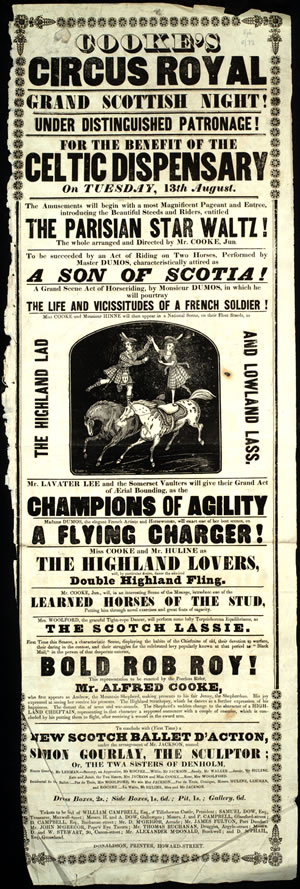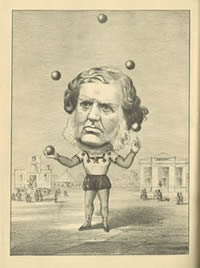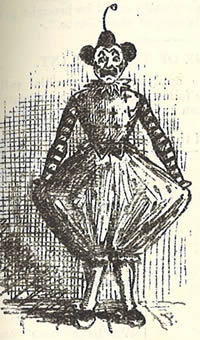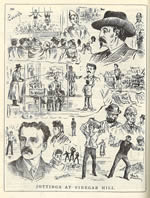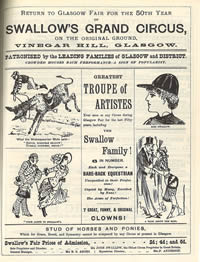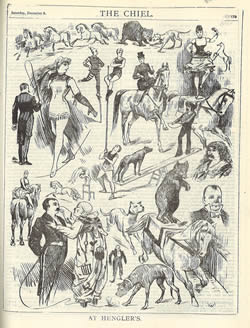Scottish popular theatre - geggies and the Glasgow Fair
Alasdair Cameron
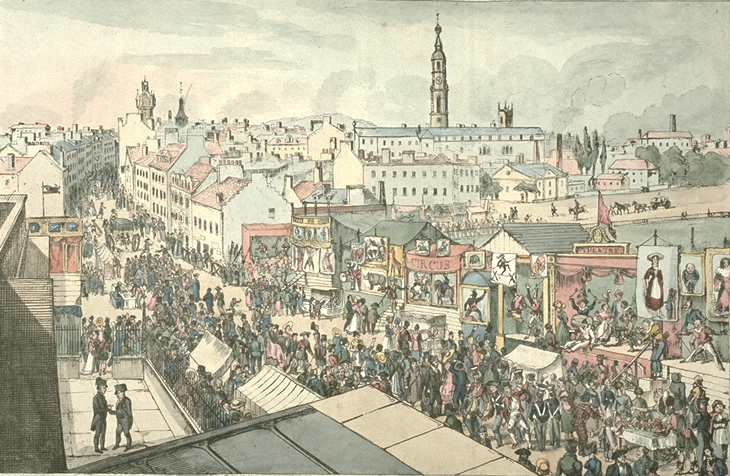
Coloured illustration of Glasgow Fair from Northern Looking-Glass, 1825. Sp Coll Bh 14-x.8.
Penny geggies
The name geggy derives from a Glasgow word, the verb to ‘gag’ which, according to the actor Peter Paterson in his Glimpses of Stage Life, described a make-shift tour of small towns undertaken by actors who were between seasons at the major Scottish theatres. In Glasgow the geggy developed from the booth theatres which crowded round Glasgow Green each July for the Glasgow Fair which, by 1850, had become the annual holiday for industrial and agricultural workers in much of the west of Scotland. The geggies resembled booth theatres in architecture, but gave better and longer performances than those prevalent at Fair time. Like the Fair theatres, however, the geggies which toured the country were constructed of canvas and wood, like circus tents. Seating around 400 and heated by charcoal braziers, they were erected and dismantled in each new town visited.
The geggies were very vulnerable to the elements. The playwright Joe Corrie remembers a geggy pitched on a pit bing which was destroyed in a storm. Will Fyffe, the famous Scottish comedian, remembered his father’s geggy being blown into the river at Perth. Unfortunately, the young Will was on the roof when the theatre blew down, and to his consternation the company seemed more interested in saving the geggy than in saving him.
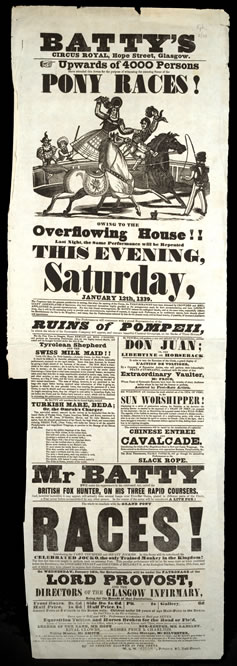
Keek shows
The all-embracing Glasgow word for any exhibition, menagerie or waxwork was ‘keek show’, meaning literally peep-show. At the annual Glasgow Fair such sights, according to a playbill, included ‘Beasts and Beastesses from the bottomless Bay in the Vest [sic] Indies’, ‘Giants and giantesses’, ‘Fat boys and still Fatter girls’, and the ubiquitous learned pigs and ‘unlettered dwarfs’. These were also the typical attractions of any large British or American Fair, but there were keek shows with a Scottish flavour.
For example, there were waxworks of scenes from Robert Burns – Highland Mary was a pathetic, and Tam O’Shanter a perennial, favourite; panoramas of scenes from Walter Scott, concluding with a ‘Vision of the Bard’; Dioramas of Queen Victoria’s journeys in the Highlands; and sculpture on Scottish subjects. We also know of a ‘Wizard in Kilts’ who performed in a booth, and of the much more splendid Professor Anderson, ‘the Wizard of the North’, who built his theatre to resemble Balmoral Castle, complete with terraces, parterres, conservatories, trees and rhododendron bushes.
Glasgow Fair
Although it was only quite late that the geggies emerged as a distinctive theatrical form, they were heirs to a tradition of popular entertainment in Scotland which, because of the variety of diversions produced there and the huge number of people attracted to it, was closely associated with the Glasgow Fair. Some idea of the Fair’s scope in the middle of the century can be gleaned from a report of 1865 which mentioned that the central area of the Fair held nine exhibitions, six peep-shows, two waxworks, a circus, twelve shooting galleries and five acting theatres, in addition to a host of peripheral events. We also know, for example, that in 1844 a total of 96,000 people paid 1d to see the ‘Bosjesmans’. These were advertised as primitive tribesmen from Africa, although they were rumoured to be Irish labourers dressed in feathers and rabbit skins and whose primitive language was Gaelic. It was also said that one of the Bosjesmans ate live rats as part of their performance. This certainly outdid another showman who merely bit off their heads and skinned them with his teeth, managing to skin twenty in as many minutes, until the police reluctantly intervened on behalf of the tender-stomached.
Repertoire
The ‘acting theatres’ of the Fair specialised in short, sharp dramas played to full houses throughout the day. Such performances were, however, very lucrative. In his early incarnation of the geggy, David Prince Miller remembered acting Richard III in five acts, twenty times in seven hours. If the audience averaged the usual 400, and they all paid their penny admission, then his company of eight would have made the handsome sum of thirty-eight pounds – though they must have been rather weighed down by more than 9,000 copper coins.
The theatres of the Fair, like the geggies, constantly re-cycled Scottish subjects. Characters like Tam O’Shanter and Souter Johnnie would come alive in wooden theatres from morning till night. Sometimes the ‘unco guid’, Scotland’s version of the moral majority, would recoil from the treatment of ‘national’ characters. Dramatisations of Tam O’Shanter were, it seems, often a thin disguise for some glimpses of female flesh in the scene in which the witch Cutty Sark dances in a very short shift in ‘Alloway’s auld haunted kirk’. Audience prurience and prudery, however, meant that the witch was given the ‘bird’ if she came too near the footlights.
The geggies kept alive this nineteenth-century ‘national repertoire’, performing plays about Wallace, Mary Queen of Scots, Tam O’Shanter, Jeanie Deans, James V, Highland Chiefs, the Falls of Clyde, Wandering Steenie and Warlocks of the Glen. They played them to Scottish audiences and played them with Scottish actors. The geggies, in a relaxed and informal atmosphere, provided plays about their own country, which were spoken in a familiar accent for people who were unable to afford the London shows or who could not travel to the large city theatres. In doing so, they preserved a distinctively Scottish dramatic tradition. So much so that later working-class playwrights like Joe Corrie, who had grown up with the geggies, were not afraid to write similar plays; plays which were quite unlike the West-End dramas of the 1920s and 1930s.
And when in the 1920s the Scottish National Players (earnestly devoted to founding a Scottish National Theatre) was started, it found its largest and most receptive audience not in the cities, where for sixty years Scottish plays had been considered inferior, but in the smaller towns and country areas, where the geggies were still remembered, and where the idea of a drama about Scotland, written by Scots about recognisable Scottish characters, and spoken in Scots by Scottish actors, seemed only natural.
Famous geggies
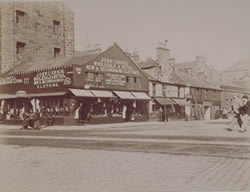
The area of the Fair was also the home of Mumford’s Geggy, which stood at the corner of the Saltmarket and Greendyke Street. It seems, however, that the name ‘geggy’ was only added as a nostalgic afterthought when the theatre had closed. It had been opened as a puppet show in 1835 by Mr Mumford, a drunken Englishman, much given to lecturing his patrons on the evils of drink. He is also said to have been responsible for a famous retort when his audience accused him of being a little under the weather in the title role in a performance of Rob Roy: ‘if you think I’m drunk’, he said, ‘wait till you see Bailie Nicoll Jarvie’. Mumford’s theatre, built out of wood, was rather ramshackle and had a flap in the side facing the busy Saltmarket. When a show was due to start, this flap would open, revealing a small band of musicians playing to attract an audience.
The most illustrious descendents of Mumford’s theatre were the geggies of Glenroy, Collins, Ferguson and Mrs. O’Brien. These however were, unlike Mumford’s, peripatetic, erected wherever there was space in the City or in an available field in the country. These geggy owners seem to have been very adaptable, and whereas performances in the city always tended to be a bit rowdy, in the country the geggy performances appealed to the respectable artisans and farm labourers.
No matter how respectable the geggies became, verbal interaction between audience and actors was so much a part of a geggy performance that it was never discouraged. Given the need for an actor to keep his wits about him under these circumstances, it was hardly surprising that so many of them ended up on the Scottish variety stage. The most illustrious example of this progression was perhaps Will Fyffe.
Later in the century geggy performances in general became more formal, and the price of admission rose to 2d on ordinary nights, when there would be two houses and only one play. On Friday, however, admission was 4d, and the extra charge would usually be for Macbeth, in ‘five long acts’, with an afterpiece and ‘good fires kept’, or a ‘grand national drama’ like Rob Roy.
Geggy actors
Although some of the actors in the geggies were described as ‘having seen better days’, many were Scots, who, while there were independent theatres and stock companies, had made a living playing characters from the ‘national dramas’, but whose accents and training now precluded them from working on the London-oriented stage. In the geggies, however, they gained new and enviable reputations outside the ‘Theatres Royal’.
Geggy actors would also specialise in a particular skill, and whereas Geordie Henderson was famed for his ‘dying fall’, Johnny Parry made a feature of dangling by the neck from the end of a rope in hanging scenes. Parry, it seems, suffered no mishaps, but the Scottish dramatist Joe Corrie remembered a geggy performance of East Lynne in which the angel representing the soul of Little Willie turned round on its upward path to heaven revealing an advertisement for washing powder.
Abridged by Adrienne Scullion from Alasdair Cameron, Study Guide to Scottish Theatre – a teaching resource prepared for the Department of Scottish Literature, University of Glasgow, in 1988. Copies are held in Glasgow University Library, including in the Department of Special Collections.
Dr Alasdair Cameron (1953-1994) was a senior lecturer in the Department of Theatre, Film and Television Studies and a leading authority on Scottish theatre and drama. We include this essay, and its companion piece on the National Drama, in memory of an inspirational teacher and colleague.
Further Reading:
Alasdair Cameron, 'Monkey Business', Theatre Scotland, vol. 3, issue 9 Spring 1994, pp. 21-25.
Bill Findlay, ‘Theatre and Drama,’ in John Beech et al (eds.) Scottish Life and Society. Oral Literature and Performance Culture (Edinburgh, John Donald, 2007), pp. 531-555.
Elspeth King, 'Popular Culture in Glasgow,' in R. A. Cage (ed.), The Working Class in Glasgow 1750-1914 (London, Croom Helm, 1987), pp. 147-169.
Robert Lightbody, 'Glasgow Geggies,' Old Glasgow Club Transactions 1921-22 (Glasgow, Aird & Coghill, 1922), pp. 72-76.
Ian McCraw, The Fairs of Dundee (Dundee, Abertay Historical Society, 1994).
Karen Marshalsay, The Waggle o' the Kilt. Popular Theatre and Entertainment in Scotland (Glasgow, Glasgow University Library, 1992).
